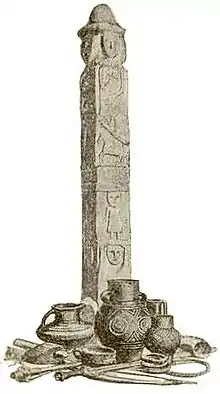Bałwan
Bałwan (Polish); balvan/балван (Kyrgyz, bolvan/бoлван (Russian), archaism for "idol" (today indistinguishable from the everyday word for snowman in most Slavic languages and in Kyrgyz), is an ancient word common to all Slavic languages, describing a statuesque or monolithic depiction or a pillar or a plinth depicting or erected in honor of a deity.[1] This object was worshipped or constituted a tangible representation of a cult image. The Western Slavs transcribed and pronounced the word as bałwan (Polish pronunciation: [/'baw.van/]), which is its contemporary and old Polish lexical manifestation, whereas most Southern Slavs and the Eastern Slavs used the just slightly differently-vowelled bolvan (Russian pronunciation: [/ˈbolvan/]).[1]

In the Kyrgyz language of Central Asia, geographically remote from the European territories with which Slavs are identified today, a balvan is a "strongman" or a hero, whereas in Persian, pahlevān denotes a militant or a veteran, as well as the plinth or boundary marker erected in his or her honor, or even a cairn, and, by extension, a fool.[1] That latter meaning, at first secondary, became primary after Christianity was imposed on the Slavs, making bałwan acquire a distinctly pejorative primary meaning.[1]
Some suggest that the Slavs share throughout their idioms such as they have evolved apart this single entity -- a common term for all cult objects in the form of a statue or cairn -- might suggest that idolatry spread early among the Slavic peoples, perhaps when they came in contact with Turkic peoples or Iranian.[1] A word with similar etymology is the Slavic word for God (when capitalized) or deity, bóg, a cognate of Sanskrit "bhaga"/Iranian or Persian bag. In India the concept of a deity or god is often relayed with the word bhagvan, variously transcribed as bhagwan.[1]
A derived term from bałwan is the Polish word for idolatry: bałwochwalstwo.[1]
References
- Aleksander Gieysztor (1980). Mitologia Słowian (in Polish). Warsaw. p. 186. ISBN 832210152X.
This library book source is used in the Polish Wikipedia article, which has been translated in whole on 2015-02-19
Further reading
- Aleksander Gieysztor; Karol Modzelewski; Leszek Paweł Słupecki; Aneta Pieniądz-Skrzypczak (2006). Mitologia Słowian (in Polish) (3rd, expanded ed.). Warsaw. Retrieved 2015-02-20.
This 3rd, expanded edition authored by the original author and a group of Polish slavicists is held as circulating item by Northwestern University Libraries, University of Chicago Libraries, University of Michigan Libraries, University of Wisconsin Libraries in the Midwestern United States, and is available in Polish, Russian and Bulgarian but not in English, as of February 2015, per WorldCat listings.